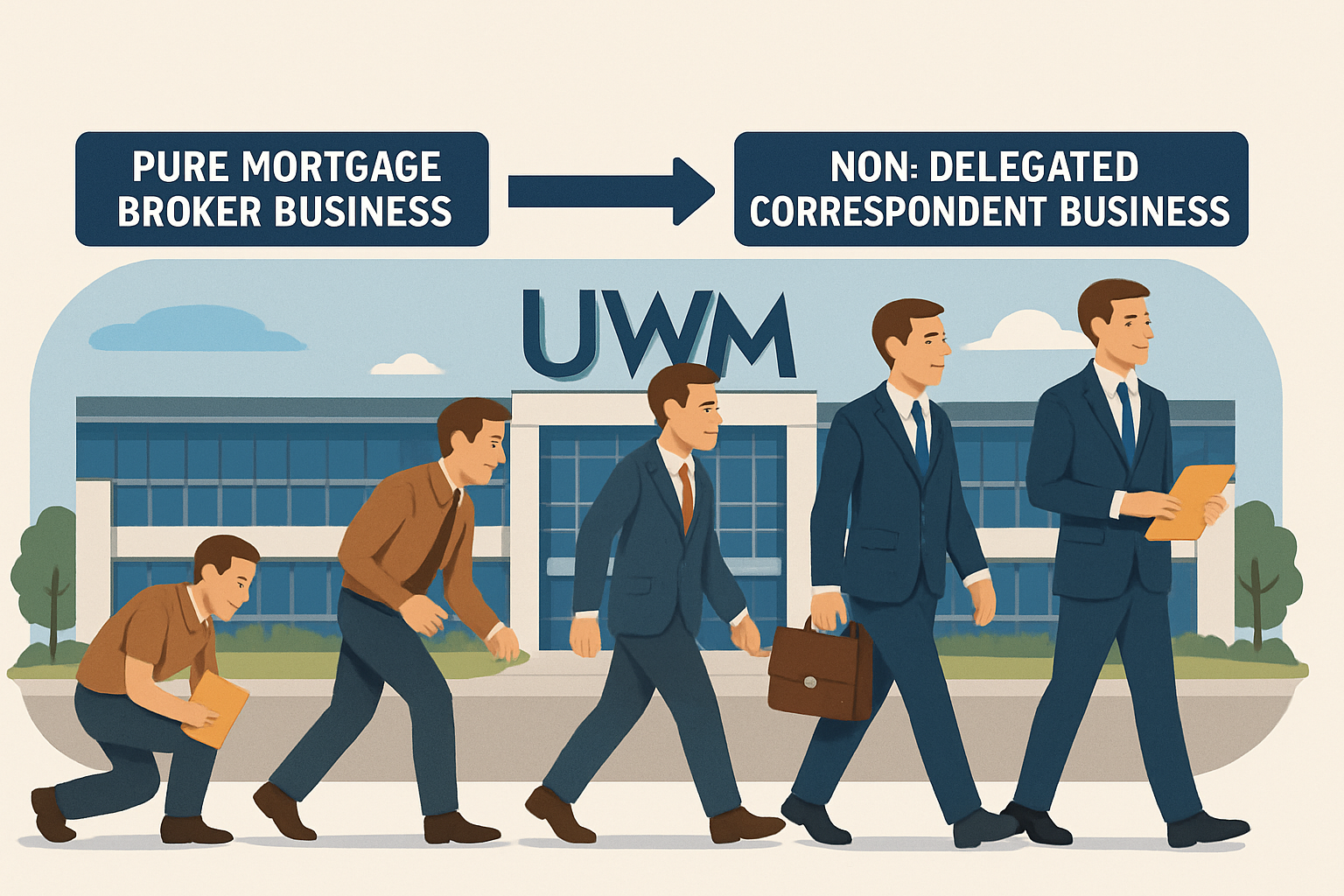The UWM non-del-emma
UWM is doing more business with its biggest clients via non-delegated correspondent.
Mat Ishbia has riled up more than his fair share of retail lenders by insisting that Brokers are Better. But behind the scenes, UWM has evolved from a true blue broker wholesaler into a hybrid lender via its growing non-delegated correspondent operation.
Indeed, UWM may now actually be the largest retail lender in the country, argues NFM Lending’s Rick Roque in a buzzy LinkedIn post. “This move is shifting the landscape; it is the largest threat to mortgage banks,” Roque writes.
Many of UWM’s biggest broker partners—NEXA, Barrett, E Mortgage Capital—have picked up warehouse lines, fund loans in their own name & assume the risk. They have pushed into the non-del businesses to achieve scale and flexibility, & most are able to do so because they have access to UWM’s best-in-class tech stack & operational efficiency, observers said. An estimated 1/3 of UWM’s business now comes through the correspondent channel, sources said. (UWM does not disclose such figures & wouldn’t comment.)
“It’s because Mat knows there’s a ceiling to the broker biz,” said one wholesale player. “A lot of their client base is pretty small & local & isn’t going to scale beyond a state or two [to] deal with licensing, audits, net worth requirements, that kind of thing. UWM needs the bigger shops to do that.”
What’s On Tap – Sept. 3
The UWM non-del-emma
A different wholesale source said he believes it’s a savvy expense play. UWM is not paying interest on the warehouse lines with non-del like they would brokering those loans. “They did $40B in business in Q2, roughly 1/3 of that is non-del, so $13B. You’re eliminating interest costs for 15 days on that business. Over the course of the year, you’re talking about hundreds of millions of dollars.”
Sources familiar with UWM’s thinking said the company is ambivalent about which channel its clients choose. They just want to support wherever their broker partners are growing.
But there’s likely no way for UWM to achieve its goal of originating $280B by ‘28 without a shift in channel strategy. Bringing servicing in-house is one way to protect against retail aggregators. Providing a flexible, Amazon-like platform to growth-obsessed broker shops through non-del is another way to beat back retail.
“There are a handful of hyper-distributed brokerages out there, like an Edge Home Finance who doesn’t want to go non-delegated or even full corr, because of how their model is set up,” a UWM competitor said. “I think the strategy here is ensuring a connection & limiting potential competition. The more dependent non-del businesses are on UWM, the less likely they are to go full-delegated and become a retail lender, which would eventually become a competitor.”
Industry pros expect that some retail lenders under $1B in volume will drop down into the non-del space. The logical play for them would be to tap into UWM’s ready-made system.
Roque noted that 27/183 of the top lenders ($1B+) are “UWM dependent organizations.” These IMBs notched a net gain of $4.9B in newly recruited production, he said. In other words, the strategy’s 📈 working.
Non-del owners set their own margins instead of relying on wholesale rate sheets. They also fully control the client experience. It’s become a key recruiting strategy, which UWM supports.
“Teaching a retail loan officer how to broker a loan seems to be a barrier to entry into the wholesale channel,” one source said. “When the rates are higher, their pipelines are smaller, they’re more likely to make the move into wholesale” via non-del.
One illustration of the shift: UWM’s rebranding of findamortgagebroker.com to mortgagematchup.com in early ‘24.
The non-del focus is not w/o risk. Several competitors said they believe UWM has taken their eye off the ball 🏀 w/ some of those smaller broker-only shops, leaving an opening for others.
UWM says it’s hogwash 🐷. “Regardless of size, we will continue to provide all of our partners with the tools, technology & products necessary to compete with retail lenders and best serve our borrowers,” a spokesperson said. “We have one formula, UWM’s success equals our clients’ success.”
FHFA MIA
FHFA Director Bill Pulte has a favorite child, and his name is Freddie.
The pugnacious FHFA Director has a natural chemistry 🧪 with Freddie CEO Mike Hutchins – for whom he approved a $1.5M pay bump in June – and has taken over a conference room at Freddie HQ. From there, he oversees the twins with virtually no support from FHFA staff, sources told The Scoop. Fannie & Freddie Chair Pulte has only ever sent a handful of emails 📧 to FHFA staff, sources said, and at least one was about PTO before a federal holiday.
What is it like to work at a shunned regulator? Working at the FHFA is the housing finance equivalent of working at the Department of Education, one employee said.
“It’s been a kind of slow-rolling thing,” said a different worker. “A large portion of us were escorted out of the building in mid-March and put on administration leave & our access got cut off. There were a couple of attempts to offer us a second option at the fork in the road, with the implication that if we didn’t take it there would be a RIF [Reduction in Force]. And now they’re just finishing the RIF.”
(More from The Scoop: How a Regulator was Put Down)
Sources said that while Freddie was likely done with cuts, they’ll continue on a rolling basis at Fannie.
As for the question of conservatorship, Pulte is involved in some of the conversations, but he’s not running the show, sources said. Mark Calabria, the former FHFA director who has a variety of administration jobs, is said to be developing the strategy with Treasury Secretary Scott Bessent and his lieutenant, former CFPB Director nominee Jonathan McKernan.
The mortgage industry has been cautiously optimistic about Pulte. Within weeks of confirmation, he removed what were seen as archaic rules, but his maverick approach to housing finance has also frustrated the industry. Pulte tends not to give the MBA a heads up on policy matters, & even the top Fannie and Freddie execs found out via X that he had greenlit VantageScore, sources said.
Pulte’s pursuit of Fed Gov. Lisa Cook on mortgage fraud charges has helped his White House standing, but questions have emerged as to the legality of his tactics & some are uncomfortable w/ the administration’s “weaponization” of Fannie and Freddie data. Most just want him to fix the LLPAs, lower G fees and “chill the f— out with the repurchases,” one mortgage exec said.
Sparring with the Aggregators
John Downs used to refi about ½ of his clients every 3-4 years.
“That’s the struggle of the hard market,” the Vellum Mortgage LO told me. “You were still always rewarded at some point. And now this week, I thought I had some real easy layup deals & the servicers come in, and you’re like, ‘How are they pricing that thing?’”
Downs & LOs like him who have long relied on client relationships are increasingly battling the aggregators (Freedom, Pennymac, NewRez, etc.) who own the servicing.
“I guess their plan worked,” he said. “It was, ‘Let’s pay an extra 1/2 a point or 3/4 for [correspondent] lenders’ like us. ‘Let’s pay more than everyone else and gobble all these up and put them in our system to streamline them.’”
It’s hard to compete w/ the relentlessness of the aggregators, he said, but they “make a lot of mistakes.” One aggregator was pricing a past client in the high-balance limit even though he was low-balance. The official estimate came in 3/8ths higher than what the servicer previously said.
“They’re not good loan officers, but the pressure is off,” Downs said. “Refi pressure is different than purchase pressure.”
Quickies
-
Tim Potempa & his team are back in retail. After less than 1.5 years at E Mortgage Capital, he’s now at CrossCountry Mortgage. Per Modex, his team has done about $240M over the last year. Mickey Schilling also left Highlands & is now CRO of MegaStar.
-
Ginnie reported a significant uptick in loan removals from its single-family MBS pools in Q2, per IMF. Liquidations totaled $65B, up 29.3% from Q1. Loan removals due to borrower payoff were up 35.8% to $52.46B, a sign of heavy refi activity.
-
Figure on Tuesday announced the launch of its IPO —> Mike Cagney is looking to raise $526M at a valuation of $4.1B.
-
Pennymac’s correspondent biz will offer a bunch of non-QM products beginning Sept. 22. The products will come to wholesale in Q4.
ARMchair Critics
-
24 years of experience in one post 👴
-
The Fed rate cuts will only make ARMs & HELOCs stronger🏋️
-
The house prices are too damn high! It’s an emergency!🚨
-
Underwriters survive on conditions and tears😭
-
Mortgage will be won by the zip code🗺️






